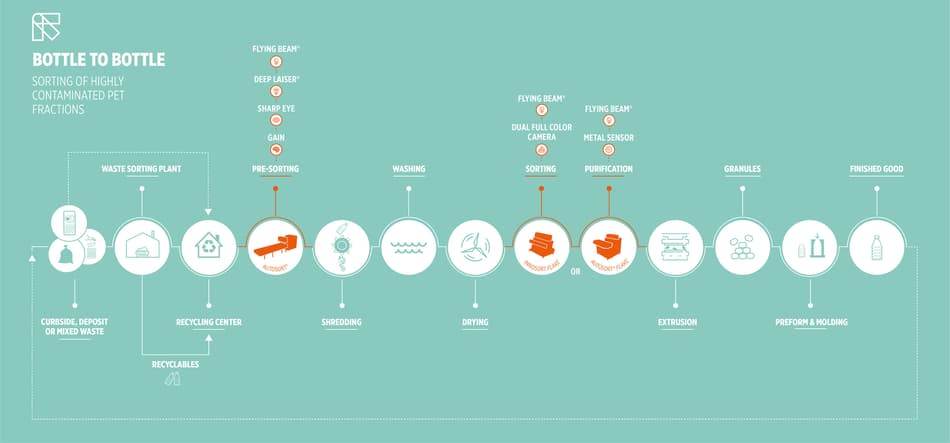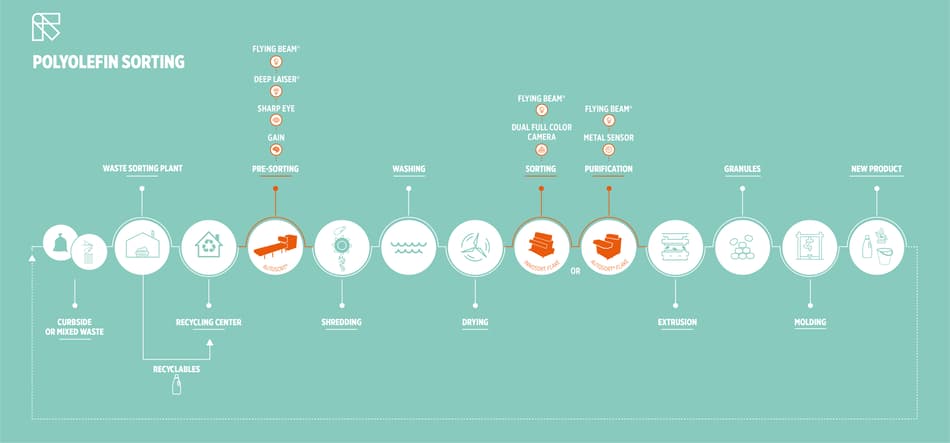The bottle-to-bottle way I go
Whichever way, the recycling process has to be initiated by the individual. That is where my journey starts. Collected together with my siblings, I am packed up in bales of about one ton and delivered to a recycling facility while already being sorted into materials; all of us PET bottles are in the right material stream, ready to be given a new life with a new purpose.

Hello new life: My arrival at the facility
Once I have been collected, my biggest adventure yet begins. Recyclers and plant operators like you buy the PET bales and have them shipped to their large facilities. Here, we are "de-baled" with the help of a machine called de-baler. Now that I have been cut loose, I get to enjoy a thorough cleansing, together with the other bottles, where my label and the glue are stripped away. Though there should only be PET bottles, sometimes a stray non-PET bottle finds its way into our bale. No worries though, the non-PET bottles and materials are rejected and sorted out in the pre-sorting to be processed properly.
This pre-sorting is done with AUTOSORT®, a handy solution to sort plastics, wood or even bulky waste. AUTOSORT® detects color and material with its FLYING BEAM® technology – it is quite a ride, the way we speed through the machine. Those of us who do not belong get dropped, e.g. colored PET bottles, PET trays or metals. Colored PET bottles are sorted out, leaving only a neutral, transparent color as well as a clear blue. As you probably know, it is easier to have color-specific piles of PET bottles for my journey to flakes. As a recycling plant operator, you are providing a vital part in not only my journey to a new life, but in keeping the environment clean and creating a sustainable future.
Bringing me back life: how grinding is used in the process
Now that I have been pre-sorted, the next process of my journey in your facility awaits: grinding. As brutal as it sounds, it is imperative for the generation of new, clear flakes. Thus, we are being put into a grinder which shreds us into tiny pieces. The shreds are full of PE/PP from our bottle caps, pieces of metal and other polymers such as PVC from remaining labels or other contaminants like wood, metal shards, paper or glass.
Of course, being pulled apart by the blades is no walk in the park, but think of it like a really intense workout. Everything hurts, but you know why you are doing it: to create the best version of yourself. For me, the grinder means that I can shed myself of the last bits of contaminant before I can be sculpted into something new and wonderful, together with more PET bottles. In fact, each PET bottle created is a beautiful artwork, a mosaic of recycled plastic.
After being grinded, we move to the next step. Depending on your recycling facility, the order and type of the steps may vary, but the whole process usually includes metal separation, sieves and air separators.
The separation process is necessary in order to separate the PET flakes from unwanted materials. We are being treated to a bit of a spa day: The flakes are washed in hot water with caustic soda lye and cold water several times. PET and PVC flakes sink to the bottom, while other polymers, mostly, float on top. Now, most of the non-PET materials have been removed, making it easier for you to continue the process, but we are still not pure enough.
No sorting hat, but a sorting machine: better flakes for easier sorting
After various washing and drying processes, we are ready to enter the AUTOSORT® FLAKE and INNOSORT FLAKE sorters. Here, non-PET and colored PET flakes are ejected based on their spectral and color properties. Even though I am as small as two millimeters, TOMRA’s FLYING BEAM® technology still picks up on me and other polymer particles just as small – and thus reduces the loss of PET flake material. TOMRA’s flake sorters are the most advanced solution to sort such small flakes like myself.

Should you choose to work with these machines, you will be playing a vital role in producing more reusable flakes and, consequently, promote a higher level of sustainability. Depending on the market location, they can also effectively process my PO-colleagues, which are becoming increasingly important and one of the main target materials of TOMRA’s updated INNOSORT FLAKE, which is 2m wide and equipped with a special sensor for PO sorting.
In the next step, after being picked up and purified, we are transported to an extruder. In the hot machine, we are melted and pulled into long, spaghetti-like strings. At the end of the extruder, a cutting die cuts us into small pellets or granules – usually under water. After a short air transport ride, the pellets arrive at a big-bag filler ready to be sold. Finally, after this life-changing and shape-altering process, I am excited for my make-over into a brand-new bottle – or maybe something else? I am looking forward to seeing what life has in store for me.
Shaping the future with injection molds
Depending on what shape of bottle I am becoming, I am injected into different molds. The company buying the pellets – which might even be the one making the pellets – puts me into injection mold machines. There, a "pre-form" is made, a small version of who I will become later on. I already have the threaded bottleneck of the size of my final bottle form.
In my pre-form, I am blown into a mold using high air pressure and heat – finally I can take my final form, fully grown and shaped as the bottle I was meant to be from the moment my previous owner used me.
After the extraction stage, I could have become anything, given any sort of new purpose. For me, this is the most exciting part. I have fulfilled a purpose to now be rewarded with another one.
As is, I was lucky to be made into another bottle. Maybe instead of serving iced tea, I am a water bottle now, helping someone under the hot Spanish sun. Maybe I am an iced latte, getting an ambitious student through a night of studying. Or maybe I am a fun juice bottle given to a kid on the playground – either way, I am thankful I can experience life again and fulfil a purpose once more.
How to save a bottle's life by giving it a second chance
Even though I was grinded into tiny flakes and reorganized, I am thankful for the experience at your facility. I have come back to life as a new bottle, all thanks to the considerate human beings involved. Only through proper disposal and subsequent recycling can I be given a second chance, ready to once more supply someone with a drink. That is why bottle-to-bottle recycling is particularly sustainable, as no new plastics need to be involved at all.
As you can see, it takes very little effort to start the recycling process – a single person is all it takes. But without plant owners like you, my second life would have never been made possible. The future, thus, does not only rely on the jogger and their water bottle or the children drinking juice at the zoo, it also relies on you and your responsibilities as a facility owner. Through your sorting, washing, shredding, melting and re-shaping, it is possible to offer bottle-to-bottle recycling.
While recycling starts with the individual, it is continued through the help of many people. Considering that a single facility might save as much as 31,000 liters of crude oil equivalence per year, recycling bottles is certainly a more sustainable, environmentally friendly bottle manufacturing process than making new PET bottles.
